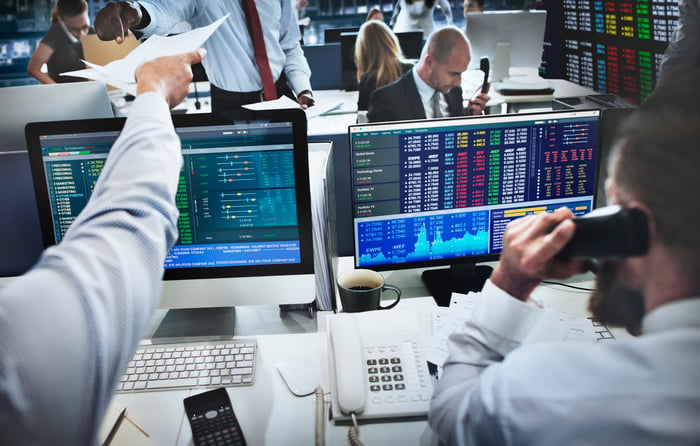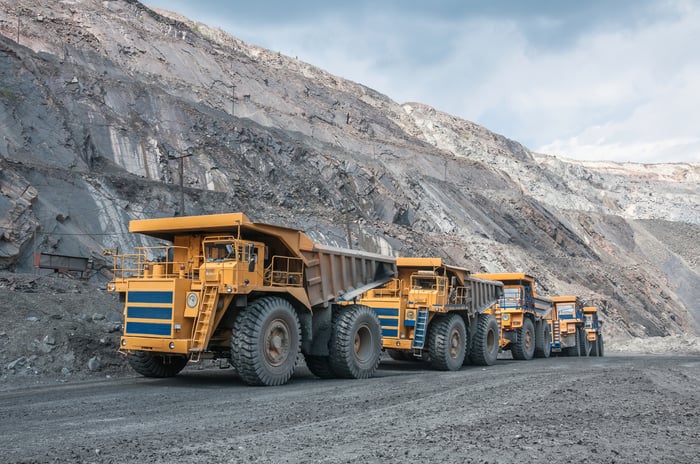For more than a century, the Dow Jones Industrial Average (^DJI 0.56%) has been the most-watched stock market index around the world. And despite the Dow's glaring flaw of being price-weighted, rather than market-cap-weighted, it retains its allure on Wall Street thanks to its rich history.
It's also index that's filled with 30 multinational juggernauts from an assortment of industries. As investing greats like Warren Buffett have often shown, sometimes these so-called "boring" businesses with time-tested models turn out to be the best investments.

Image source: Getty Images.
Are these Dow stocks a screaming bargain?
Yet, right now, the Dow doesn't look particularly cheap. While calling it "overvalued" would probably be a bit of a stretch. It's trailing 12-month price-to-earnings ratio of nearly 23 leaves a lot to be desired by value investors who'd been paying just 20 times trailing 12-month earnings for the average Dow stock at this time last year.
However, not all Dow stocks are necessarily pricy or fairly valued. There are a handful of Dow components that, when examined, are considerably cheaper than their peers with regard to their PEG ratios. The PEG ratio takes into account not only a company's price-to-earnings ratio, but also its five-year growth rate. Using the PEG ratio as opposed to just current or forward P/E helps root out perceived-to-be cheap stocks whose top line is stagnant or heading in the wrong direction.
Generally speaking, a PEG ratio below 1 is considered to be a bargain, while a PEG ratio above 2 would be pricy. Everything else in between would represent some debatable level of fair valuation. Right now, there are three Dow stocks sporting a PEG ratio of less than 0.5. Or, put in another context, these three Dow components are the index's cheapest stocks.

Image source: Getty Images.
Chevron: PEG ratio of 0.29
Based on the PEG ratio, there isn't a better value that investors can consider for their portfolios at the moment than integrated oil and gas giant Chevron (CVX 1.54%). Wall Street is looking for Chevron to grow its full-year earnings per share from a reported $3.70 on an adjusted basis in 2017 to $9.25 per share by 2021.
This expected surge in profitability can be traced to a handful of growth catalysts. For starters, crude oil prices have rebounded significantly from their 2016 lows. Even though integrated oil companies like Chevron are positioned to benefit downstream from weaker crude pricing, the industry still generates the bulk of its profitability and growth from its upstream drilling business. With crude oil prices hitting $75 per barrel recently, prospects for profitability (especially in the Permian Basin) are looking much brighter.
Motley Fool analyst and colleague Taylor Muckerman also recently pointed out that Chevron's costs should be waning in future quarters. A massive liquefied natural gas project in Australia is just about complete, which should help reduce expenditures. Also, the passage of the Tax Cuts and Jobs Act will help reduce what Chevron owes in income tax. This would be expected to have a positive impact on the company's bottom line.
As one final sign of encouragement that Chevron is fully back, the company reinstated its shareholder buyback program in the second quarter. Following a four-year absence, Chevron announced its intent to repurchase $3 billion worth of stock each year. Long known for its share repurchases and healthy dividend yield, Chevron is making a strong case to be in investors' portfolios.

Image source: Getty Images.
Goldman Sachs: PEG ratio of 0.30
Absolutely nipping at the heels of Chevron for the title of "Cheapest Dow Stock" is investment banking behemoth Goldman Sachs (GS 0.22%). Between 2017 and 2019, Wall Street is looking for 28% aggregate earnings growth.
Though Goldman Sachs has been plagued in recent years by weaker trading revenue and what I'd call "bond-market malaise," its second-quarter operating results, much like Chevron's, suggest a coming-out party. The company's first-half annualized return on equity of 14.1% is the highest it's been since 2009, while net revenue growth of 19% was tops among all big investment banks. Importantly, it ranked as the top dog in terms of market share for underwriting common stock offerings, leading initial public offerings, and handling mergers and acquisitions.
Goldman Sachs is also benefiting from a more hawkish Federal Reserve, and lower income-tax rates. Even though its debt securities and loan segment makes up a relatively small component of net revenue (less than 10%), it grew by astounding 67% on a year-over-year basis in the second quarter. Higher net interest income, as well as low corporate income tax rates, should bode well for the future.
And when the next recession strikes, Goldman Sachs should benefit by an uptick in its institutional client services segment, which made up 38% of second-quarter revenue. Though trading volume has still been somewhat sluggish, significant moves lower in the stock market and economy could ramp that right up and provide a nice downside hedge for investors.

Image source: Getty Images.
Caterpillar: PEG ratio of 0.48
Lastly, heavy-duty construction machinery manufacturer Caterpillar (CAT -0.55%) looks to be cheap, despite its share price having doubled since the early portions of 2016. Wall Street is looking for Caterpillar to improve upon its $6.88 in adjusted EPS from 2017 by delivering $13.68 in full-year adjusted EPS by 2020.
To keep with the theme, Caterpillar's latest quarterly results also suggest the good times will continue. The adjusted profit of $2.82 per share the company recorded was a second-quarter record. This was made possible by a 24% increase in year-over-year sales, with Construction revenue, its Resource segment, and Energy and Transportation revenue, up 24%, 38%, and 20%, respectively. Caterpillar also lifted its adjusted full-year profit guidance to a range of $11 to $12 per share, up from a prior forecast of $10.25 to $11.25.
And it's not just 2018 that looks like it'll be a good year for Caterpillar. Heavy-duty machinery is often booked by its customers many quarters, if not years, in advance. With GDP growth in the U.S. and a number of key developed markets remaining strong, and the company alluding to "healthy" order rates and a "solid" backlog, there's little reason to believe we'd see any weakness anytime soon.
As the icing on the cake, Caterpillar's board also authorized an aggressive share repurchase plan totaling $10 billion, with no expiration date. Based on the company's existing market cap, this would allow for the retirement of roughly 12.5% of the company's outstanding shares. That would definitely have a positive impact on EPS. Even though Caterpillar is probably my least favorite of the three cheapest Dow stocks given how much its share price has run since 2016, it could still be worth a look based on its PEG ratio.





